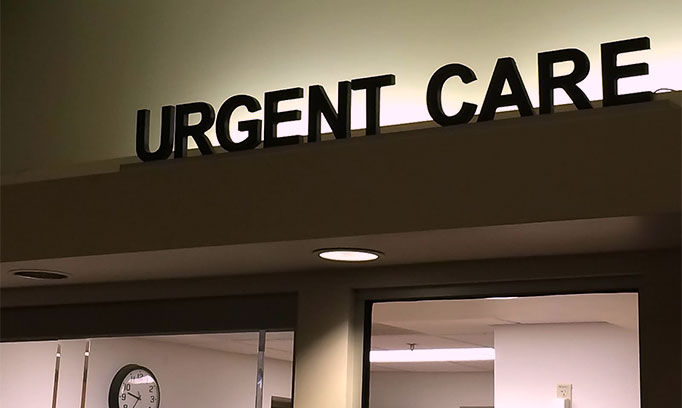Necessary Services Supplied by Clinics Concentrating On Urgent Care
Necessary Services Supplied by Clinics Concentrating On Urgent Care
Blog Article
Comprehending the Duty of Urgent Care in Giving Timely Therapy for Non-Life-Threatening Conditions
Immediate treatment centers have arised as a crucial part of the healthcare landscape, addressing the instant needs of people with non-life-threatening conditions. By providing available and timely clinical solutions, these centers successfully bridge the gap in between primary care and emergency situation departments. The implications of their duty extend beyond simple comfort, motivating a better evaluation of when and exactly how these facilities are utilized. Recognizing the subtleties of immediate treatment could substantially affect patient results and the general performance of healthcare distribution. What aspects add to their growing value in contemporary medication?
What Is Urgent Care?
Urgent care refers to a group of clinical solutions developed to attend to non-life-threatening problems that need prompt attention. These facilities act as an intermediary between medical care doctors and emergency situation areas, providing a hassle-free option for clients that require prompt treatment without the substantial waiting times typically connected with emergency situation divisions.
Immediate care centers are commonly staffed by doctor, including medical professionals, registered nurse experts, and physician aides, who are educated to identify and treat a broad selection of conditions. Common services supplied by these facilities include treatment for minor injuries, ailments, and infections, as well as diagnostic tests such as X-rays and laboratory work.
Furthermore, urgent treatment facilities typically approve walk-in clients, getting rid of the need for visits. Overall, urgent treatment plays a vital role in the medical care system, ensuring individuals can access essential medical solutions promptly and efficiently.

When to seek treatment at an urgent treatment center instead of a main care doctor or an emergency room,Lots of individuals might find themselves unclear regarding. Immediate care is made to resolve non-life-threatening problems that need timely focus however are not extreme adequate to require an emergency clinic visit.
Normally, one should consider immediate take care of concerns such as minor cracks, sprains, cuts needing stitches, or infections like urinary system system infections. Furthermore, chilly or influenza symptoms, rashes, and allergies can also be appropriately taken care of in this setting.
It is very important to keep in mind that urgent treatment is not appropriate for life-threatening emergencies, such as upper body discomfort, difficulty breathing, or severe bleeding, which require prompt emergency clinic intervention.
People that do not have accessibility to a primary care doctor or can not protect a prompt consultation might additionally gain from urgent care services. Eventually, recognizing when to make use of immediate treatment can bring about more efficient healthcare delivery, permitting individuals to receive the appropriate level of care based upon their certain health and wellness demands.
Advantages of Urgent Treatment Centers
Selecting urgent care centers for non-life-threatening conditions offers numerous benefits that boost person experience and access. One primary benefit is the lowered delay times contrasted to typical emergency clinic. Urgent treatment centers typically operate a first-come, first-served basis, permitting individuals to get timely medical attention without the lengthy delays frequently connected with healthcare facility setups.
Additionally, immediate treatment facilities offer prolonged hours, consisting of weekends and nights, fitting clients with varying timetables. This versatility makes sure that individuals can Continue look for treatment when it is most convenient for them, better advertising timely treatment.

Moreover, these facilities frequently offer a detailed variety of solutions, consisting of minor treatments and analysis tests, all under one roofing system. This combination of services not only simplifies the person experience yet likewise fosters a much more natural approach to managing non-life-threatening wellness problems, ultimately profiting overall individual outcomes.
Common Conditions Dealt With
At urgent treatment centers, a selection of non-life-threatening conditions can be effectively dealt with, providing clients with accessible and prompt clinical support. These centers are specifically proficient at resolving issues that need prompt attention however do not posture an immediate danger to life or arm or leg.
Common conditions treated at immediate treatment centers include minor injuries such as sprains, strains, and fractures. Urgent treatment facilities are equipped to perform necessary analysis tests, such as X-rays and research laboratory examinations, allowing them to provide detailed care.
Moreover, urgent care companies can provide vaccinations, aiding to avoid the spread of infectious diseases - Urgent Care. They additionally supply solutions for minor procedures, such as suturing injuries or draining pipes abscesses. By supplying these varied solutions, urgent care facilities play an essential function in connecting the space in between medical care and emergency situation solutions, making sure patients obtain timely treatment for a variety of problems without the requirement for long haul times normally connected with emergency rooms
Just How Urgent Care Supports Healthcare System
Immediate care facilities play a critical role in supporting the overall healthcare system by alleviating the problem on emergency situation departments and giving timely accessibility to treatment for non-life-threatening explanation conditions. By managing cases such as minor injuries, infections, and ailments, urgent treatment centers allow emergency situation divisions to focus on more critical individuals calling for instant focus.
Moreover, urgent treatment facilities improve medical care ease of access, using extensive hours and an easier alternative to typical medical care setups. This accessibility is especially valuable for patients who may not have a routine medical professional or who require instant therapy outside of common workplace hours. Consequently, immediate care facilities effectively lower wait times and enhance patient contentment.
Furthermore, urgent care facilities add to set you back financial savings for both patients and the healthcare system by supplying lower-cost solutions contrasted to emergency situation divisions. This monetary efficiency is important in an age of increasing healthcare prices, permitting individuals to obtain necessary care without sustaining outrageous expenditures.
Verdict
Finally, urgent treatment facilities play an important role in the healthcare system by delivering punctual therapy for non-life-threatening problems. By bridging the space between primary treatment and emergency clinic, these facilities make certain that individuals get timely clinical attention without the extensive wait times normally connected with emergency situation departments. The access and efficiency of immediate care facilities add substantially to alleviating the total problem on healthcare sources, improving individual results, and advertising a much more effective health care delivery system.
Immediate care facilities have emerged as a vital element of the medical care landscape, dealing with the prompt requirements of people with non-life-threatening conditions. Immediate more information treatment check outs generally incur reduced out-of-pocket costs compared to emergency situation department brows through, making care extra inexpensive for individuals without compromising quality. Immediate care centers are outfitted to carry out essential diagnostic tests, such as X-rays and lab examinations, allowing them to offer thorough treatment.
By supplying these varied services, urgent treatment facilities play a crucial function in bridging the space in between primary treatment and emergency services, guaranteeing individuals receive timely therapy for a vast range of problems without the demand for long wait times normally connected with emergency rooms.
Additionally, immediate treatment facilities boost healthcare availability, offering extensive hours and an extra convenient alternative to standard key care setups.
Report this page